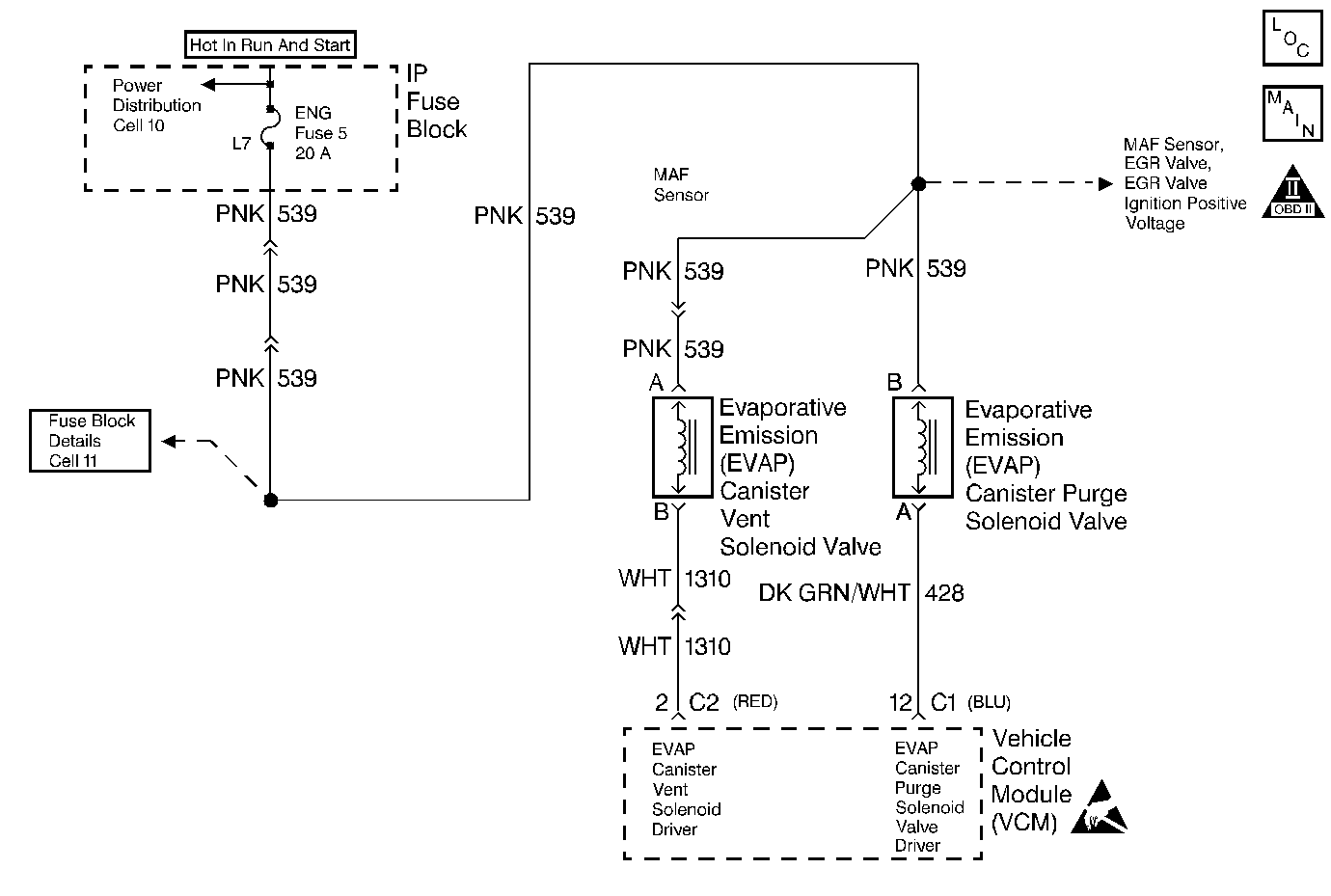The evaporative leak detection diagnostic strategy is based on applying
a vacuum to the EVAP system and monitoring the vacuum decay. The VCM monitors
vacuum level via the fuel tank vacuum sensor input. At an appropriate time,
the EVAP purge solenoid and the EVAP vent solenoid are turned ON, allowing
the engine vacuum to draw a small vacuum on the entire evaporative emission
system. After the desired vacuum level has been achieved, the EVAP purge solenoid
turns OFF, sealing the system. A leak is detected by monitoring for a decrease
in the vacuum level over a given time period with all other variables remaining
constant. A small leak in the system will cause DTC P0442 to be set. This
DTC is a Type A DTC.
Reviewing the Fail Records vehicle mileage since the diagnostic test
last failed may help determine how often the condition that caused the DTC
to set occurs. This may assist in diagnosing the condition.
Step
| Action
| Value(s)
| Yes
| No
|
1
|
Important: Before clearing the DTCs, use the scan tool to record the Freeze Frame
and the Failure Records for reference. This data will be lost when the Clear
Info function is used.
Was the Powertrain On-Board Diagnostic (OBD) System Check performed?
| --
|
Go to Step 2
| Go to
Powertrain On Board Diagnostic (OBD) System Check
|
2
|
- Turn OFF the ignition.
- Install a scan tool.
- Remove the fuel cap.
- Turn ON the ignition.
- Observe the fuel tank vacuum on the scan tool.
Is the fuel tank pressure at the specified value?
| 0 in H2O ±1 in H2O
|
Go to Step 3
| Go to
Evaporative Emission Control System Diagnosis
|
3
|
Important: Before continuing with the diagnosis, zero the EVAP Pressure and Vacuum
gauges on the Enhanced EVAP Pressure Purge Diagnostic Cart
J 41413. Refer to the tool operating instructions.
- Replace the fuel cap.
- Connect the Enhanced EVAP Pressure Purge Diagnostic Cart
J 41413 to the EVAP service
port.
- Use the scan tool in order to command the EVAP vent valve ON (Closed).
- Pressurize the EVAP system to the specified value using the Enhanced EVAP Pressure Purge Diagnostic Cart
J 41413 (monitor the pressure by using the gauge on the
cart).
- Observe the Fuel Tank Pressure on the scan tool.
Is the Fuel Tank Pressure at the specified value?
| 5 in H2O
5 in H2O
(±1 in H2O
|
Go to Step 4
| Go to
Evaporative Emission Control System Diagnosis
|
4
|
- Turn the ignition ON leaving the engine OFF.
- Using the scan tool, command the EVAP vent valve ON (Closed).
- Pressurize the EVAP system to the specified value using the Enhanced EVAP Pressure Purge Diagnostic Cart
J 41413.
- Use the gauge on the cart in order to moniter the pressure.
- Rotate the switch on the cart to HOLD and observe the EVAP pressure
gauge.
Does the pressure decrease to less than the specified value within 2
minutes?
| 15 in
H2O
10 in H2O
|
Go to Step 5
| Refer to Diagnostic
Aids
|
5
|
- Disconnect the fuel tank vapor line and the EVAP purge line from
the EVAP canister.
- Block the fuel tank vapor line fitting on the canister.
- Connect a hand vacuum pump to the EVAP purge line fitting on the
canister.
- Ensure that the EVAP vent valve is still commanded ON (Closed).
- Attempt to apply vacuum to the canister.
Can the specified vacuum be maintained?
| 5 in Hg
|
Go to Step 8
|
Go to Step 6
|
6
|
- Visually and physically check for the following conditions:
| • | The vent hose for being disconnected or damaged |
| • | The EVAP canister for damage |
- If a problem is found, repair as necessary. Refer to Diagnostic
Aids.
Was a problem found?
| --
|
Go to Step 10
|
Go to Step 7
|
7
| Replace the EVAP vent valve. Refer to Diagnostic Aids. Refer to EVAP Vent Valve Replacement
.
Is the action complete?
| --
|
Go to Step 10
| --
|
8
|
- Visually and physically check for the following conditions:
| • | A loose, missing, or malfunctioning fuel cap |
| • | A leaking fuel tank vapor line |
| • | A damaged EVAP purge line |
- If a problem is found, repair as necessary. Refer to Diagnostic
Aids.
Was a problem found?
| --
|
Go to Step 10
|
Go to Step 9
|
9
|
- Use the scan tool in order to command the EVAP vent valve ON.
- With the Enhanced EVAP Pressure Purge Diagnostic Cart
J 41413 connected to the
EVAP service port attempt to pressurize the EVAP system by leaving the cart
control knob in the pressurize position.
- Use the Enhanced EVAP Ultrasonic Leak Detector
J 41416, in order to locate the leak
in the EVAP system. It may be necessary to partially lower the fuel tank to
leak check the top of the tank connections. Refer to Diagnostic Aids.
- Repair the leak in the EVAP system.
Is the action complete?
| --
|
Go to Step 10
| --
|
10
|
- Turn the ignition ON with the engine OFF.
- Use the scan tool in order to command the EVAP vent valve ON (Closed).
- Pressurize the EVAP system to the specified value using the Enhanced EVAP Pressure Purge Diagnostic Cart
J 41413.
- Monitor the pressure using gauge on cart.
- Switch the rotary switch on the cart to HOLD.
- Observe the EVAP pressure gauge.
Does the pressure decrease to less than the specified value within 2
minutes?
| 15 in.
H2O 10 in. H2O
|
Go to Step 2
| System OK
|

